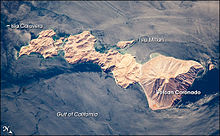- Coronado (volcano)
-
For other uses, see Coronado (disambiguation).
Coordinates: 29°04′02″N 113°30′34″W / 29.06722°N 113.50944°W
Coronado (Spanish: Volcán Coronado) is a volcano on Isla Coronado, in the state of Baja California, Mexico.
Located in the Bahia de los Angeles (Bay of the Angels), Isla Coronado (Coronado Island, also known as “Smith Island” on some maps) is just off the eastern shoreline of Mexico’s Baja California Peninsula, in the Gulf of California . The island is approximately 7 kilometers long, and it is dominated by Volcan (volcano) Coronado on the northern end. The date of the last eruption of the volcano is not known, but gas and steam activity was last recorded in 1539.
Coronado Island—together with nearby Isla Mitlan and Isla Calavera—has an arid climate and is sparsely vegetated. Despite the harshness of the environment, sea lion colonies can be found on the island, and the Bahia de los Angeles is a popular sport fishing location. Partly in response to increased environmental pressure on the islands from both fishing and tourism, local groups developed a management and conservation plan for the islands in the bay, with international support, in the late 1990s.
The island is an important piece of the ecology of the Gulf of California. In 1940, marine biologist Ed Ricketts, together with his friend, author John Steinbeck, conducted an expedition and collecting trip in the Sea of Cortez (or Gulf of California) to explore the rich ecology of the intertidal zone. Coronado Island and the Bahia de los Angeles were part of that expedition. The resulting book by Steinbeck and Ricketts, Sea of Cortez, remains a classic document of the natural history and ecology of the Gulf of California.
Today, the uninhabited island is a refuge with a rich marine assemblage, especially when compared to other, unprotected parts of the Gulf. This image provides hints of the diverse marine environment around the island. Most of the coast is steep and rocky, but lighter blue lagoons, especially along the western coast, provide shallower, protected environments that are biologically robust. Offshore, internal waves and complex surface currents facilitate mixing of the water, important for nutrient delivery to the coastal environments. These water patterns are outlined by sunglint (light reflecting off of the water surface back towards the camera onboard the International Space Station). The sunglint patterns are due to wind and currents, which roughen the water surface and enhance reflection, and surfactants that decrease the surface tension and roughness, resulting in regions of dark, smooth water.
See also
References
- Coronado Island and the Gulf of California, Mexico. This article incorporates text from this public domain NASA webpage.
- Full-size image of Coronado Island, from NASA's Earth Observatory.
- Coronado (volcano) at GEOnet Names Server
Further reading
- Steinbeck, John. Ricketts, Edward F. (1941). Sea of Cortez: A leisurely journal of travel and research, with a scientific appendix comprising materials for a source book on the marine animals of the Panamic faunal province. Reprinted by Paul P Appel Pub. 1971. ISBN 0-911858-08-3
Categories:- Baja California
- Volcanoes of Mexico
- Nature reserves in Mexico
- Islands of Mexicali Municipality
- Islands of the Gulf of California
Wikimedia Foundation. 2010.

